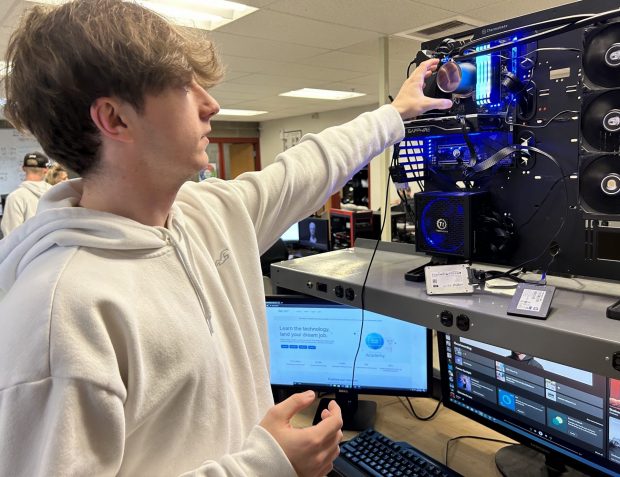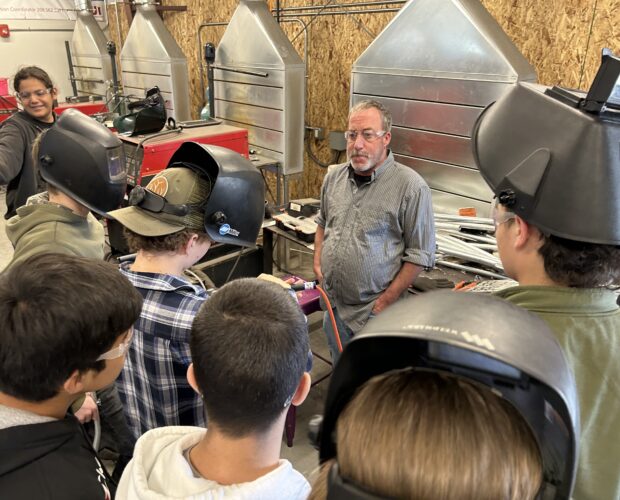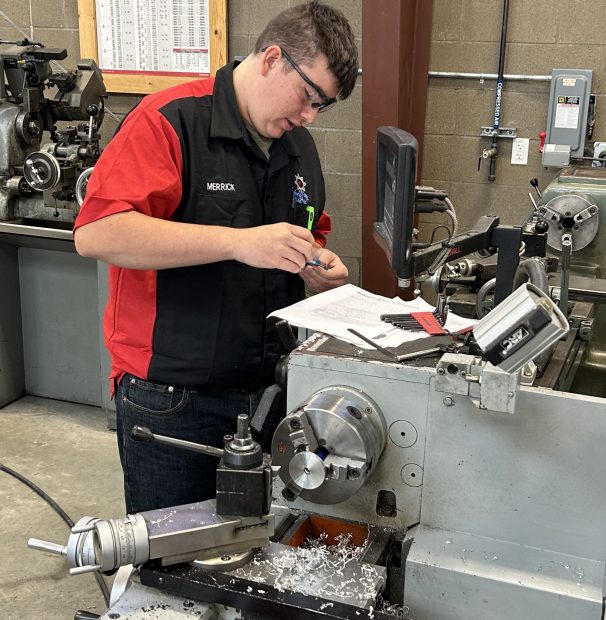
Superintendent Debbie Critchfield believes rural communities are highly interested in increasing workforce-ready career technical programs for their students, so she wasn’t surprised by the “sheer demand” of grant applications reaching the Idaho Department of Education.
Thirty-two of 35 proposals went to rural schools, which accounts for a little more than three-fourths of the money awarded so far.
“It’s problem solving. It’s math. It’s science. It’s all of these things captured in work-based learning. I firmly believe that a good, hard day’s work is the answer to a lot of things,” Critchfield said.
During the last legislative session, when lawmakers approved $45 million for Idaho Career Ready Students (ICRS), Critchfield said her critics claimed she’s trying to turn every kid into a welder.
“That was one of the things we heard. If kids don’t want to weld, they still don’t have to. But when I went to Twin Falls High School, I asked the principal to take me to your most popular elective class,” Critchfield recalled. “It was welding.”
She encountered similar stories about career technical education in the farming, food processing, tourism and logging regions.
And applications have poured in. The state has received more in grant requests than it has money to allocate. In the span of four months, approximately $35.9 million of the $45 million ICRS grant money has been set aside for 35 proposal requests. Approximately $111 million was requested, which is 146% more than what they were able to award. About $9.1 million remains unspent.
The Department of Education is administering the program but spending decisions are made by the ICRS council — 11 industry leaders, career technical educators, lawmakers, education leaders and Critchfield.
Grants are intended to create or expand pathways into welding, fabrication, machining, agriculture, forestry, mining, nursing and cyber security. The program incentivizes rural schools to align programs with their community and industry needs. The money should reduce the problem of finding resources needed to sustain high-quality career technical programming.

The high-level of interest is evidence that career technical education is a powerful tool, Critchfield said. “I’m not surprised that our schools are trying to meet career goals for our students. I’m not surprised that there’s more interest in technical programs. I’m not surprised that kids want a jumpstart on their careers.”
But how will the state measure success and provide accountability for the millions promised across Idaho in communities like Middleton and Pocatello, and rural Deary, Malad, Orifino and Wilder? The ICRS council expects school districts to be “good stewards,” submit quarterly reports, a final project completion report and account for spending in district financial reports, according to the state’s website.
Local education agencies (LEA’s) are required to provide quarterly progress reports and a final project completion report to the Idaho Career Ready Students Council.
ICRS funds will need to be accounted for as part of a district/charter’s financial reports.
The council will consider metrics and evidence to measure success and return on investment at their February meeting. Expanding workforce-ready programs could impact job creation, unemployment, local economic growth, graduation rates, student mental health and career choices.
Districts are required to answer “show us how you’re going to know that this is successful and sustainable” on the the application.
Pocatello-Chubbuck School District’s longtime career technical education instructor Rhonda Naftz was emphatic about the impact in her region: “This is one of the greatest things the state of Idaho has ever offered to students.”
The Idaho Division of Career Technical Education released the following data that demonstrates the growth of high school CTE programs over the last six years.
| FY 2019 | FY 2020 | FY 2021 | FY 2022 | FY 2023 | FY 2024 |
| 701 | 751 | 900 | 927 | 945 | 1,114 |
Where is the ICRS money going?
The ICRS council met three times and committed 79% — or $28.2 million — for 32 rural and remote school district proposals; three proposals were awarded in areas not considered rural.
“It was very clear that we were under-serving local economies,” Critchfield recalled, about her visits around the state. In North Idaho, the forestry, logging and timber industry provided the catalyst “for getting this grant together. I consistently heard about great opportunities for students.”
Four forestry and natural resources proposals received $3.5 million for start-up or expansion of logging and the production of forestry products.
About 65% of all the money awarded ($23.5 million) went to five school districts’ capital projects. The districts receiving the largest awards are: Pocatello-Chubbuck, $6.5 million; Jefferson, $5.3 million; Minidoka, $4.9 million; Blackfoot, $3.9 million; Sugar-Salem, $2.7 million. In total, capital projects received $33.1 million. Existing programs at 13 schools received $391,165. And Potlatch, Firth, Shelley, Orofino and West Bonner districts were approved for new programs, totaling approximately $2.3 million.
“It’s life changing. This grant will change the face of CTE in this whole region,” Naftz said about Pocatello-Chubbuck’s career technical center, which is expected to officially open in 2024.
Hands-on, real-world learning is an answer for students who feel “aimless” or lack “confidence,” Critchfield said. “There is a sense of pride. You develop perseverance and grit.”
Millions were awarded to long- and short-term projects since July but only a small portion has been spent: about $400,000 through requests for reimbursement, a district issued purchase order or vendor invoice to the Department of Education. There is no deadline for when funds are to be spent. Any unused money will be returned to fund proposals not previously accepted.

The ICRS council
The council’s next meeting is Feb. 16. Applications are due by Jan. 31. The council is made up of the following members:
- Critchfield, who chairs the council.
- Clay Long, administrator, Idaho Division of Career Technical Education.
- Lex Godfrey, secondary CTE instructor, Career Technical Educators of Idaho.
- Brandy Funk, secondary CTE instructor, Career Technical Educators of Idaho.
- Rodney Farrington, associate professor, Career Technical Educators of Idaho.
- Robb Bloem, StanCraft Companies, representing industry.
- Dana Kirkham, Idaho Environmental Coalition, representing industry.
- Angelique Rood, Idaho Power, representing industry.
- Marie Price, Idaho Forest Group, representing the Workforce Development Council.
- Sen. Kevin Cook, Idaho Senate, District 32.
- Rep. Judy Boyle, Idaho House of Representatives, District 9.
“I have just been really just blown away at the level of attention and experience that people” on the council have, Critchfield said.
But rejecting applications is part of the process. Some proposals — particularly those outside the scope of in-demand careers — were rejected outright, but most are placed in the “not yet” category: they will be reconsidered, if money becomes available later.
The council rejected a request for heavy equipment. Additional ineligible expenses include:
- Curriculum for existing programs.
- Instructor travels for professional development, course work and conferences.
- Student travel for general field trips and extra-curricular activities (specific, itemized requests for travel may be considered).
- Soft costs associated with building programming and construction — contractor administration and overhead fees and building permits (architectural and design fees, and contingency fees are allowable expenses).
School districts and charters can apply for the funds here. The ICRS program was approved by the Legislature earlier this year and signed into law by Gov. Brad Little on March 31. Questions can be directed to program coordinator Allison Duman at [email protected].
Pocatello-Chubbuck to offer a regional CTE center
The council awarded the Portneuf Valley Technical Education and Career Campus in Chubbuck $6.5 million to complete a regional CTE center that will serve students from surrounding communities who do not have access to programs.
A major development was the Pocatello-Chubbuck school board’s decision last year to purchase the old 78,000 square foot Allstate building for around $12 million, using local plant facilities levy and federal money. But without the new grant, Naftz believes it would have taken another six to 10 years to complete the career center in stages.
“For 23 years we’ve been thinking, talking and trying to figure out how it is going to work. We got very serious about seven years ago. So we’ve been at this for a long time,” Naftz said.
Surrounding school districts who could benefit from the regional CTE center are American Falls, Marsh Valley, Aberdeen, Rockland, Soda Springs, Grace and Malad. The center, expected to open in 2024, will serve between 1,000 to 1,400 students per day.
“We are opening that door for whichever students want to show up. When this building is finished, it’s not going to look like anything in the state. It’s going to be at a different level,” Naftz said.
Are CTE teacher endorsements increasing?
The approval process for new CTE programs takes place during the spring with the approval cycle ending on Feb. 15.
“We anticipate to see a continued growth during the upcoming application window. (Our agency) has seen significant growth in CTE programs throughout the state over the past six years,” said Megan O’Rourke, director of communications for Career Technical Education.
There were 1,089 teachers teaching CTE courses in the 2022-23 school year. There are 1,083 teachers this school year in classrooms across the state, but the agency says that could increase.
The number of teachers “still has room to increase over the balance of this year,” the agency reports.
There were 338 secondary applications for CTE endorsements last year. So far this year, the number is 171 but “similar to the growth in programming, we anticipate continued growth in applications,” O’Rourke said.
The following lists detail the $35.9 million approved by the ICRS council
Existing Programs
- Notus School District #135 – Welding Program $27,000
- Hansen School District #415 – Applied Accounting Program $25,530
- Murtaugh School District #418 – Ag Education Program $20,324
- Marsh Valley School District #21 – Automotive Service Technician and Mechanics $5,347
- COSSA #555 – Automotive-Diesel Program Equipment Upgrades $56,721
- Whitepine Joint School District #288 – Multi-Program Equipment Upgrades $47,871
- Mullan School District #392 – Mullan Welding Program Equipment Upgrades $61,248
- Oneida County School District #351 – CNC Plasma System $28,622
- Council School District #013 – Ag Facility Equipment Upgrades $23,000
- Wallace School District #393 – Welding & Wood Shop Equipment Upgrades $23,440
- Castleford School District #417 – Welding Program Upgrades $22,250
- Marsh Valley School District #21 – Welding Program Upgrades $32,617
- Bear Lake School District #033 – Automotive Technology Equipment Upgrades $17,195
New Programs
- Potlatch School District #285 – Forestry and Natural Resources Program $989,198
- Firth School District #59 – Certified Nursing Assistant (CNA) Program $25,375
- Shelley School District #60 – Welding Program $55,457
- Orofino Joint School District #171 – Natural Resources & Forestry Pathway $528,100
- West Bonner School District #083 – CTE Natural Resources Pathway $725,240
Capital Projects
- Midvale School District #433 – Ag Education Facility Expansion $1,058,000
- Minidoka School District #331 – CTE Facility $4,900,000
- Pocatello-Chubbuck School District #25 – CTE Campus (PV-TEC) $6,500,000
- Kimberly School District #414 – Ag Education Facility Expansion $1,320,000
- Cassia County School District #151 – Diesel Program Facility $1,659,491
- Wilder School District #133 – Ag Education Facility Expansion $301,487
- Blackfoot School District #55 – CTE Center (BTEC) $3,898,071
- Sugar-Salem School District #322 – Multi-Program CTE Facility $2,700,000
- Soda Springs School District #150 – Multi-Program CTE Facility $370,960
- New Plymouth School District #372 – New Ag Education Building $2,272,799
- Cascade School District #422 – Ag Welding Shop HVAC/Electrical Upgrades $16,361
- Firth School District #59 – Ag Shop Upgrades $103,299
- Hansen School District #415 – Animal Science Pathway Facility $71,309
- Middleton School District #134 – Multi-Program CTE Facility $1,124,800
- Fremont County School District #215 – Greenhouse Facility $253,120
- Jefferson School District #251 – Multi-Program CTE Facility $5,300,000
- St. Maries Joint School District #041 – Multi-Program CTE Facility $1,280,934
